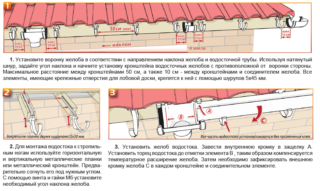The drainage system is one of the important elements for ensuring the normal functioning of buildings and structures. It is designed to drain rain and melt water, which negatively affect the main structural elements of buildings and provoke their gradual destruction.
Assigning a slope for rainwater drainage
Competently organized water drainage helps to save on repair and restoration work. Sediment will run efficiently if the slope of the gutters and the system as a whole is correct. This is due to the following reasons:
- If not properly sloped, small gutters will not be able to do their job efficiently. Water will constantly flow over the sides, which will lead to a deterioration in the performance of the system.
- Too steep a drain angle will make gutters and pipes ineffective. They will not be able to cope with the rapid flow of water that comes from the gutters.
- Incorrectly selected slope will lead to the accumulation of foliage and dirt in the system. Such a drain requires frequent cleaning and may periodically fail.
It is equally important to observe the slope of the rainwater drainage trays from the yard. Its accumulation in the area near the building leads to flooding of the basement, wetting of the foundation. When covering with asphalt, paving slabs, the materials are gradually destroyed under the influence of a large amount of water.
The minimum slope for the roof and the rules for performing the calculation
All components of the drainage system are mounted with a minimum slope of 1-2 mm for each running meter, in accordance with SNiP, GOST. If you adhere to the specified norm, the movement of wastewater to the receiving funnels will occur under the influence of natural forces without the use of additional equipment. In this case, the water inlet should be level at the lowest point.
Experts recommend setting a slope of 0.3-0.5 cm for each meter for gutters. If the gutter has a length of 6 m, its upper point rises to a level of 2-3 cm relative to the lower one. For prefabricated gutters, it is recommended to slightly increase the slope. As it moves, the water will encounter connecting seams that will slow down its speed.
For the slope to come out smoothly, it is necessary to correctly install the brackets. First, the first and last holder are mounted in accordance with the selected angle. A construction cord is pulled between them. Along a given line, other brackets are installed in increments of 50-70 cm. For the installation to be successful, each next one must be 2-3 mm higher or lower than the previous one.
Choosing a slope for sidewalks
The slope of the site for water drainage is determined by regulatory documents in the field of construction. It is usually expressed as a percentage. 1% corresponds to a value of 1 cm for each running meter. The minimum slope of the porch or area for water drainage depends on the climatic conditions in a particular area. Also, this indicator is influenced by the characteristics of the surface for which the calculation is made.
The slope of the water flow for the courtyard sidewalk and normal footpaths is 1%. This is sufficient for good water flow while maintaining their ease of use. If the sidewalk is covered with tiles, the structure of its surface is taken into account. If it is smooth, the recommended slope is 2-2.2%, rough - 2.5%. When developing the project of the site or porch, their lowest point should coincide with the placement of the water intake tray.
For sidewalk sections with high traffic (area near steps, turns), the slope is 3-3.5%. This value will help to avoid the accumulation of water, prevent people from falling on ice in the cold season. For areas where there is a minimum permeability, a maximum slope of the sites is allowed - 6-7%.
Surface runoff slope for urban areas

When organizing rainwater runoff in large areas, its vertical layout is taken into account. This process is carried out using a drain. It is designed and organized in such a way as to collect all the water from a specific area, take it to the place of discharge and to treatment facilities. At the same time, it is necessary to prevent possible flooding of streets, the lowest sections, underground floors and structures.
When designing a sewage system for collecting rainwater, the intensity, duration and frequency of precipitation in a specific area are taken into account. Such data are contained in regulatory documents - SNiP 23-01-99 "Climatology and Geophysics", SNiP 2.04.03-85 "Sewerage. External networks and facilities ".
The following types of systems are used to collect rainwater in urban areas:
- open: formed from trays, cuvettes that correspond to the cross-section of the streets;
- closed: consists of supply networks, underground structures, inspection wells, special nodes (outlets, water-still, drop wells);
- mixed: contains elements of an open and closed network.
For ease of operation, the maximum length of the storm sewer branch is 40 m. It usually has 2-3 storm water inlets and one observation well. The diameter of the branches is within 200-300 cm. The optimal slope of the storm sewer is 2-5%, the minimum possible is 0.5%.
Open rainwater trays and ditches are designed along the streets. They are predominantly rectangular or trapezoidal in cross section. The slope of trays on the roadway, drainage channels, ditches is taken taking into account the type of existing coating. In the presence of an asphalt concrete base, it is 0.3%, cobblestone or crushed stone - 0.4%, cobblestone - 0.4%. For separately placed trays and cuvettes, the smallest slope reaches 0.5%, for drainage ditches - 0.3%.
During the reconstruction of storm sewers, the designed elements are tied to the existing ones. The position of all components of the system and its slopes depend on the height and planning solution of the territory.










